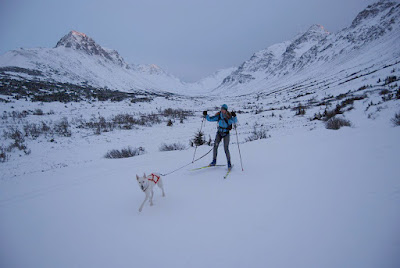On a quest for the perfect nordic snow we spent the afternoon cruising around powerline pass, just north of Flattop mountain, in the Chugach mountains, with a gorgeous sunset overlooking the Anchorage bowl. Love & Peace, Samuel

Skijoring is a winter dog- or horse-powered sport popularized in North America and derived from the Scandinavian sport of pulka. It involves a horse or from one to three dogs hitched directly to a human being on skis. Skijoring can also take place behind a snowmobile or an all terrain carrier such as the Bandvagn 206. In this case, several skiers or soldiers can be towed on the same rope. The rope is passed around the skiers skipoles and continues to the next person in line. Skiers then preferably hang on to their skipoles, supported by their arms.
While skijoring behind a dog or horse, the person wears a wide waistband with a clip for attaching a lead, which is attached to the harness worn by the dog. Special quick-release hitches or hooks are available, used so that the skijorer may unhook the dog's lead rapidly. The dog provides extra power to the skier, who uses either a classic cross-country technique, or the faster skate skiing technique. Unlike regular cross-country skiing, the skis are hot waxed from tip to tail, to avoid slowing the dog team down.
Any dog over the age of one year, and in general good health, can pull a skijorer. The classic northern breeds, such as Siberian and Alaskan huskies, Malamutes, Inuit dogs, take to skijoring with glee. However, any pet dog is capable of enjoying this. Border collies, Golden Retrievers, Giant Schnauzers, Labs, and many cross-breeds are seen in harness.
The dogs are taught the classic mushing commands to start running (hike), turn (gee and haw), and stop. Training is best done on foot, before the person straps on their skis, to avoid being pulled into objects, like trees or half-frozen creeks.

Skijoring is a winter dog- or horse-powered sport popularized in North America and derived from the Scandinavian sport of pulka. It involves a horse or from one to three dogs hitched directly to a human being on skis. Skijoring can also take place behind a snowmobile or an all terrain carrier such as the Bandvagn 206. In this case, several skiers or soldiers can be towed on the same rope. The rope is passed around the skiers skipoles and continues to the next person in line. Skiers then preferably hang on to their skipoles, supported by their arms.
While skijoring behind a dog or horse, the person wears a wide waistband with a clip for attaching a lead, which is attached to the harness worn by the dog. Special quick-release hitches or hooks are available, used so that the skijorer may unhook the dog's lead rapidly. The dog provides extra power to the skier, who uses either a classic cross-country technique, or the faster skate skiing technique. Unlike regular cross-country skiing, the skis are hot waxed from tip to tail, to avoid slowing the dog team down.
Any dog over the age of one year, and in general good health, can pull a skijorer. The classic northern breeds, such as Siberian and Alaskan huskies, Malamutes, Inuit dogs, take to skijoring with glee. However, any pet dog is capable of enjoying this. Border collies, Golden Retrievers, Giant Schnauzers, Labs, and many cross-breeds are seen in harness.
The dogs are taught the classic mushing commands to start running (hike), turn (gee and haw), and stop. Training is best done on foot, before the person straps on their skis, to avoid being pulled into objects, like trees or half-frozen creeks.


No comments:
Post a Comment